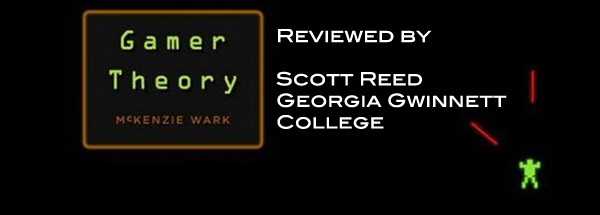
Readers uninitiated into the field of game studies will likely find Wark an intimidatingly dense read. Salted liberally with references to the foundational game theories of Johan Huizinga and Roger Caillois, and showing more than a little indebtedness to latter-day theorists of digital games like Espen Aarseth, Gonzalo Frasca, and Jesper Juul, Gamer Theory reads best when read with an awareness of the multiple ways Wark engages his topic. That is, the multiple ways of defining what games are and what games mean.
One of the most foundational texts of game studies is Johan Huizinga's Homo Ludens (1950). In it, Huizinga explores the ways that people engage in play through the well-known figure of the “magic circle”: a metaphor for how play occurs in liminal sorts of spaces, roped off and designated separately from the rules and norms of the real world. Taken further, the term strongly shades “play” as an experience aligned with the magical or mystical. Wark himself aligns the term “play” with the counter-culture movements of the 1960s, echoing the suggestion made by Edward Castronova (2007) that “virtual worlds” tend to blur the distinction between the real and the virtual. In that regard, the desire of the counter-culture to create “worlds of play outside the game” was an attempt to bring the magical and mystical experience of play more into the fabric of everyday life.
In distinction to this realm of pure play, Wark frequently cites the work of Roger Caillois, whose wok represents a response to Huizinga through its shifting of emphasis away from magical “play” towards a more sustained attention on “games.” His seminal work Man, Play, and Games (1961, 2000) introduces a set of highly informative distinctions between various types of play, some of which are more structured and rule-bound than others. The more “free” types of play fall into the categories of alea, mimesis, and ilinx – random chance, mimicry, and vertigo (best explained as the sensation of spinning around quickly in a circle). Far more pressing for Wark, though, is the ascendant form of play that Caillois terms agon: play based on competition. It's a concept that Wark quickly explodes from a descriptor for a particular activity within a particular cultural sphere (or magic circle, if you will) to a deep underlying symptom that demonstrates the very constitution of life in the digital age. Juxtaposed with his definition of digitality itself, where meaning and messages are assembled (materially) from ones and zeroes, Wark moves quickly to establish that agon, seen in everything from postmodern capitalism to sports and gaming, extends the material logic of the digital to a dominant cultural logic. In games as well as in the real world, “what prevails is the same agon, the same digital logic of one versus the other, ending in victory or defeat” (6). The goal of Gamer Theory is not to negate, but to work through this digital logic.
In that regard, Wark levels his critical gaze less at the ways that games construct fictional or virtual worlds (the latter term would no doubt strike him as so much “magical” thinking), than at the ways that the rules of games create meaningful experience. Here his methods take their cue from the “ludological” school of gaming theory, a school of thought that grew out of Espen Aarseth's foundational work on “cybertext” in the late 1990s. Whatever play there is in a game occurs much less at the level of narrative meaning than at the level of the rules that govern that play. Indeed, Wark echoes this point of view when he flatly states: “What is specific to games is at the level of form, not content” (32). Gonzalo Frasca (2003), for example, argues that the significance of Grand Theft Auto III's ultra-violence isn't its narrative violence towards women, but rather the structure of rules that variously allows, prohibits, encourages, or punishes that behavior in the first place. Ian Bogost (2007), in his enormously influential Persuasive Games, further argues that these rules have their own rhetorical meaning. Games are best understood, he argues, as artifacts of “procedural rhetoric” that create arguments about the world through their rule-structures.
Wark's own take on procedural rhetoric, though, is a good deal looser. Whereas Bogost's project in Persuasive Games drifts strongly towards Aristotelian sorts of rhetoric, emphasizing argument within and for the public sphere, Gamer Theory argues that games organize their meaning in altogether more unpredictable and idiosyncratic ways. In his second chapter, Wark instead explores Walter Benjamin's notion of allegory, “where anything can be made to mean anything else” (29). Almost mirroring the notion of avant-garde aesthetics, the purpose of allegorical meaning-making is to disrupt “the illusion of bourgeois [ie, semiotically stable] order, revealing the means by which it is made” (29). This method (or anti-method) significantly expands the reach of what Wark can do with videogames: he is less interested in interpreting their meanings as in using them generatively, as allegories of “gamespace” itself. Drawing on game theorist Alexander Galloway, he locates allegorical potential in what the former terms the “allegorithm.” A portmanteau of “allegory” and “algorithm,” allegorithms represent the ways that players can, through gameplay (that is, through interpreting a game's rule systems or “algorithm”), construct parallel meanings with significance to the world outside “The Cave” of the game.
It's in this regard that Wark can be most interesting to compositionists and digital rhetors. In working through and beyond the so-called “ludological” school of gaming, Wark elevates gameplay from an activity of mere textual interpretation into one of a sort of rhetorical production. It's not merely that gamers construct ideologies and narratives out of their encounters with games, in the sense that a violent or bellicose game might encourage identification with violent or bellicose ideologies. Instead, Gamer Theory upends that equation by suggesting that games, if read allegorically, can be a way of composing responses to those ideologies through gameplay.







